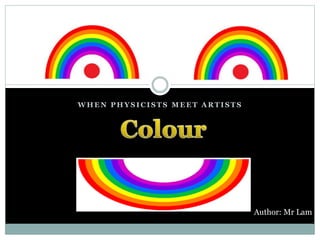
Colour
- 1. W H E N P H Y S I C I S T S M E E T A R T I S T S Author: Mr Lam
- 2. Primary colours Every science teacher tells students that the primary colours are Green Blue Red Every arts teacher tells her students that the primary colours are Yellow Blue Red
- 3. The science teacher says A science teacher will show you three lamps with difference colours intersecting. Therefore, green, blue and red are the primary colours
- 4. What the art teacher says An art teacher will then get some colour pencils, oil paints or crayons and show you this picture This shows green can be created by mixing yellow and blue together. Moreover, no matter how hard you tried, there seemed no way to mix pigments to create yellow. Therefore, yellow is a primary colour.
- 5. Who is right, then? From the previous slides, both teachers agree that red and blue are the primary colours. They have discrepancy between yellow and green as one of the primary colours. Before we answer this question, we need to go back to the basic, understand some colour theory.
- 6. Why apple is red?
- 8. How about banana? The answer is not that simple.
- 9. Reflecting green-red or pure yellow?
- 10. Our eyes have three types of cone cells Red, green and blue** These cone cells response to different wavelengths stimulations.
- 11. The label for “red”, “green” and “blue” cone cells are quite misleading. They not just response to a single wavelength but rather a broad range of wavelength. In the above figure, the dotted line is the response for rod cells • Also notice how close together the red and green cones are in their sensitivity.
- 12. Why we see orange colour? We see orange colour because, both green and red cone cells are stimulated by the light source at the same time. The ratio of the stimulations to the green cone cells and to red cone cells is resembled in the brain and make us feel there is a orange colour. However, if we artificially adding any light within the green and red cone response curve, and having the same ratio, we an recreate the sensation of orange even we are really seeing the orange light!! This is how we see colours!!!
- 13. As we have mentioned, magenta is composed of two primary colours, (red and blue) If a beam of magenta light laminates on a red filter, only the red component can pass through. The following slides show different colour beam rays for different colour filters
- 15. Red light can pass through both yellow and magenta filters
- 16. Red light cannot pass through a cyan filter
- 17. We can use different colour filters to subtract colours
- 18. Colour reflection is actually is a colour filter.
- 19. The diagram below summarized colour subtraction
- 20. Let’s go back to the original question What are the primary colours? By definition, primary colour can can be mixed with other primary colours to produce any other colours. primary colour cannot be re-created by mixing of any other colours by any ratio Actually I have already answered the questions from the previous slides.
- 21. Primary colours for light (addition) is just opposite to the primary colours for pigments (subtraction) Primary colours of light (addition) Primary colours of pigments (subtraction) Primary colours: red, green blue Primary colours: Magenta, yellow, cyan
- 22. cyan + yellow pigment = green pigment Note: Cyan pigments look very much like blue when concentrated.
- 23. Wait a minute! You said the primary colours of pigment are: magenta, yellow and cyan? How comes my teacher told me that the pigment primary colours are red, yellow and blue?
- 24. Misconception over generations I am not sure why most art teachers (including mine) claimed that primary colours were blue, red, yellow. Perhaps, it was their teachers told them. The teacher’s teacher told the teachers. and perhaps, someone had made a mistake in the very beginning and pass from generation to generations. My humble guess is that the first one probably mislabelled red for magenta, and blue for cyan at the beginning. Or “cyan” and “magenta” are not in the list of the common vocabularies in our daily conversation. Hence, they use “blue” and “red” instead.
- 25. Not convinced? By definition, a primary colour cannot be produced by mixing from any colours with any ratio. If red were a primary colour for pigment, then it would not be able to be created by mixing any other colours. We can try to mix magenta + yellow and see if you can produce red OR cyan + magenta for blue
- 26. Still not convinced? Inkjet printers used magenta, yellow and cyan as their cartridges.
- 27. From the inkjet cartridges, there are no red or blue cartridges. Ask yourself, how can an inkjet printer prints red and blue colours? It can’t be come from nowhere!!!
- 28. Conclusions The primary colours is red, blue and green. For practical uses for mixing pigments, secondary colours, yellow, cyan and magenta are used to produce other colours by subtraction.